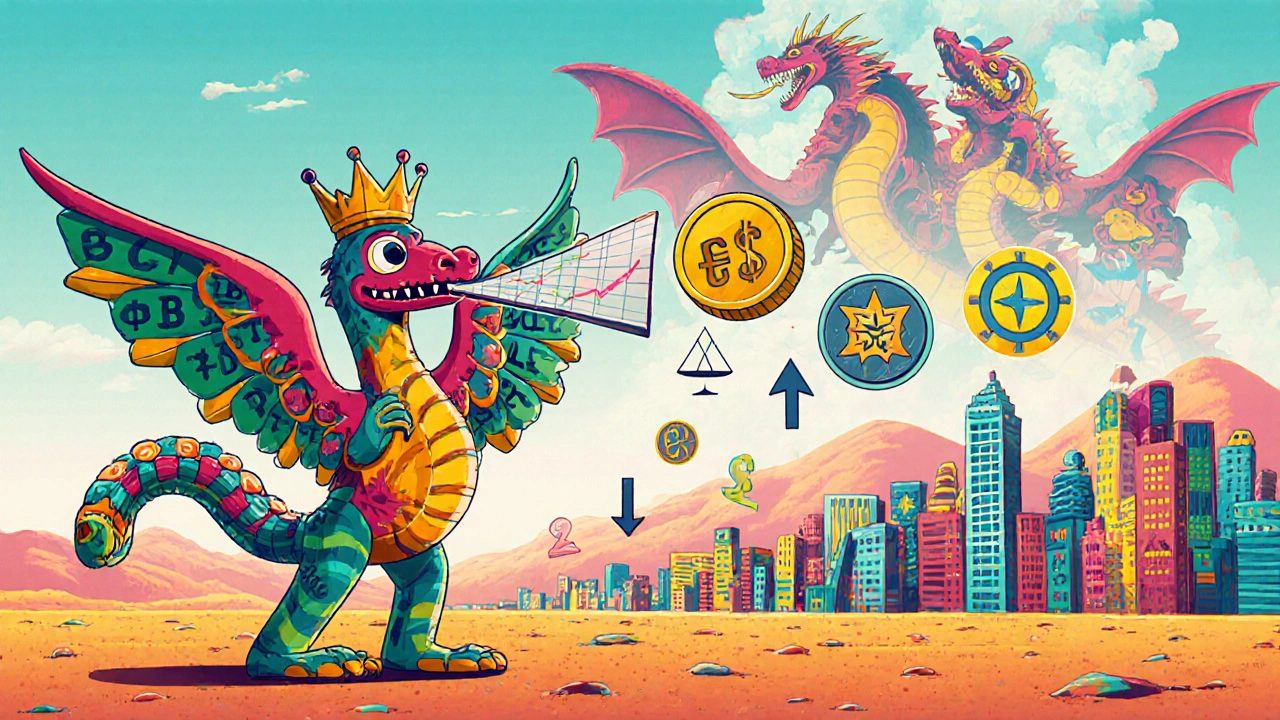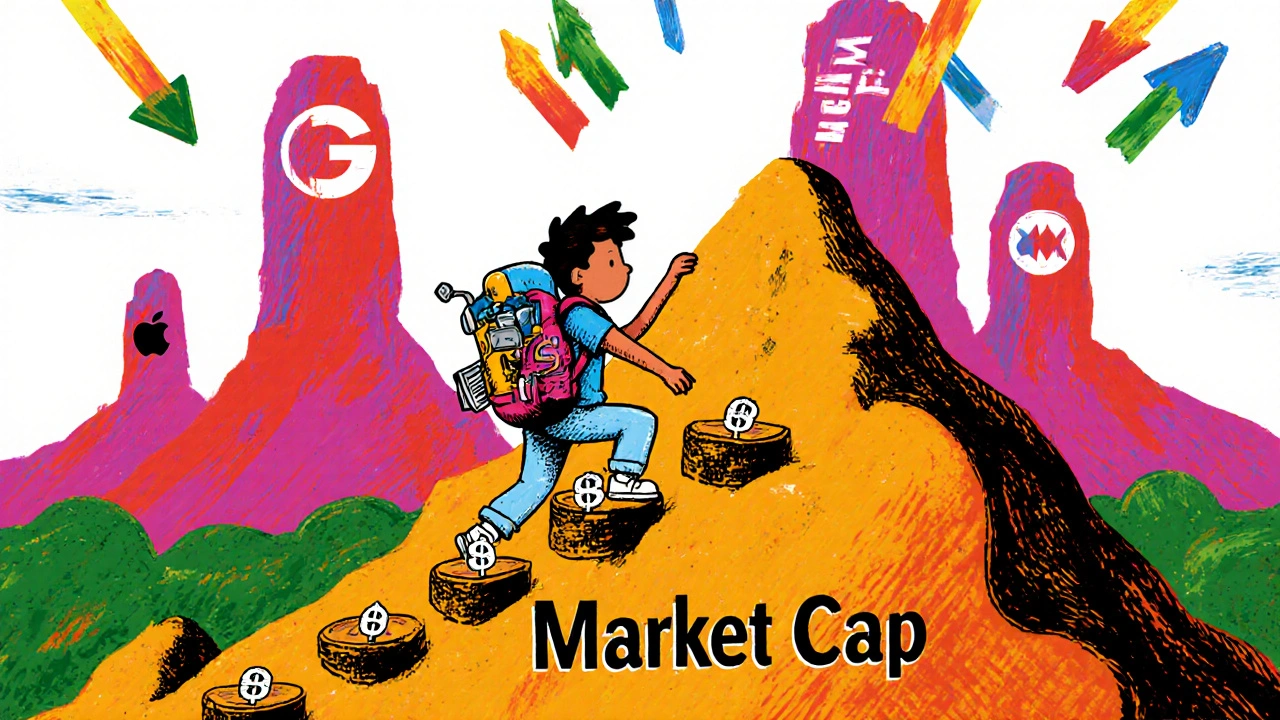Market Cap Tier Calculator
Calculate Market Cap Tier
Market Cap Thresholds
Results
What Market Cap Really Means (And Why It Moves)
Market capitalization isn’t just a number on a screen. It’s the total value investors have placed on a company by buying its stock. You calculate it simply: current share price multiplied by total shares outstanding. If a company has 10 million shares and each trades at $100, its market cap is $1 billion. That’s it. No complex formulas, no hidden math.
But here’s what most people miss: market cap changes every single trading day. When a company releases strong earnings, its stock jumps. When a product flops, it drops. And when that movement crosses a certain threshold, the company doesn’t just get a new number - it gets a new label. That’s when small-cap becomes mid-cap, and mid-cap becomes large-cap. These aren’t arbitrary labels. They trigger real changes in who buys the stock, how much it trades, and what kind of investors pay attention.
The Three Tiers: What Counts as Small, Mid, or Large
There’s no single rulebook, but most major index providers - like S&P, Russell, and MSCI - use similar ranges. As of 2025, here’s what you’ll see in most U.S. markets:
- Small-cap: Under $3 billion. These are younger companies, often in niche markets or new industries. Think local tech startups, regional manufacturers, or biotech firms still testing drugs.
- Mid-cap: $3 billion to $10 billion. These companies have proven they can grow. They’re not startups anymore, but they’re not giants either. Think companies like Shopify in its early growth phase, or regional banks expanding nationally.
- Large-cap: $10 billion and up. These are household names: Apple, Microsoft, Coca-Cola. They’re stable, well-established, and dominate their industries.
But here’s the catch - these numbers aren’t fixed. The $10 billion threshold for large-cap has been rising. In 2010, a $7 billion company might have been considered large. Today, that’s mid-cap. Why? Because the overall market has grown. Companies are bigger, valuations are higher, and inflation pushes prices up. The same goes for mid-cap thresholds - they’re creeping up too.
How Companies Move Up: The Growth Engine Behind the Shift
Companies don’t jump from small to large overnight. It’s a slow climb fueled by consistent growth. Look at NVIDIA. In 2016, it was a $7 billion company - solid, but still small-cap. By 2018, it hit $56 billion. That’s mid-cap territory. By June 2024, it crossed $3 trillion. That’s not just large-cap - it’s mega-cap, a new category that didn’t even exist a decade ago.
What made this possible? Consistent revenue growth. Strong profit margins. A product (AI chips) that became essential. When a company hits 15%+ revenue growth for multiple quarters, and its earnings keep rising, investors start betting big. More buying = higher stock price = higher market cap.
It’s not just tech. Companies like Peloton and Beyond Meat went from small to mid-cap in just a few years by scaling their customer base and proving they could turn a profit. But not all companies make it. Many get stuck. They grow a bit, then stall. Their stock price hovers around $2.8 billion for months - just shy of the $3 billion mid-cap line. That’s called threshold volatility. And it’s common.

The Index Effect: Why Moving Up Changes Everything
Here’s the real kicker: when a company crosses into a new market cap category, it doesn’t just get a new label - it gets a new audience. Index funds track these categories. When S&P Dow Jones Indices adds a company to the S&P 500 (large-cap index), billions of dollars in passive investment flow in automatically.
BlackRock’s data shows that when a company graduates to the S&P 500, it typically gets $1.50 to $2.25 in new indexed fund buying for every $1 of market cap growth. That’s a massive tailwind. It creates a temporary 5% to 8% price bump just from being added to the index.
But it’s not all good news. When a company is removed from an index - say, it falls below $2.7 billion and gets kicked out of the mid-cap index - those same funds are forced to sell. That can trigger a 10% to 15% drop in price, even if the company’s fundamentals haven’t changed. This is why some investors call it the “index trap.” You buy a stock because it’s growing, but the real driver of your return isn’t the company - it’s the index rules.
Small to Mid: The Sweet Spot for Growth Investors
Historically, the most profitable transition isn’t from large to mega-cap - it’s from small to mid-cap. A 2022 study in the Journal of Portfolio Management found that companies crossing the $2 billion mark to become mid-cap generated 3.7% more annual return over the next two years than companies that stayed small or were already large.
Why? Because they’ve passed the risky startup phase but haven’t hit the growth ceiling yet. They’re still agile, still innovating, still expanding. Think of Shopify in 2015. It was a $1.2 billion company. By 2018, it hit $14 billion. Investors who bought during that transition saw returns over 1,200%. That’s the power of catching a company before it becomes obvious.
But here’s the problem: most retail investors don’t see these companies until they’re already mid-cap. By then, the easy gains are gone. The trick is to spot companies approaching the $3 billion threshold - not after they’ve crossed it. That means tracking quarterly earnings, revenue growth trends, and analyst upgrades. Tools like Yahoo Finance or FactSet let you filter stocks by market cap range. Look for companies between $2.5 billion and $3.2 billion with rising revenue and improving margins.
The Dark Side: When Large Caps Fall
Not all movement is upward. Companies can fall too. When a large-cap company loses market share, faces regulatory pressure, or suffers a major product failure, its stock can crash. If it drops below $10 billion, it gets demoted to mid-cap. These are called “fallen angels.”
S&P Dow Jones Indices found that companies demoted from large-cap to mid-cap underperform the broader market by about 2.5% annually over the next two years. Why? Because institutional investors - pension funds, mutual funds - often have rules that forbid them from holding stocks below $5 billion. So they sell. And when big money exits, the price drops further.
GoPro is a textbook example. In 2015, it was a $5.2 billion company - solidly mid-cap, on its way to large. By 2017, it had fallen to $1.1 billion. Investors who held on lost 68%. The company lost its growth story. Competitors ate its market. And once it dropped below the institutional threshold, the selling snowballed.

What You Should Do: Strategies That Actually Work
So how do you use market cap shifts to your advantage? Here’s what works:
- Track companies near thresholds. Set alerts for stocks between $2.7 billion and $3.3 billion. If they’re growing revenue 15%+ for three straight quarters, they’re likely to cross into mid-cap. That’s your entry point.
- Avoid chasing index additions. Don’t buy a stock just because it’s about to join the S&P 500. The price has often already run up. Wait for the dust to settle - usually 30 to 60 days after the announcement.
- Use ETFs wisely. If you want exposure to companies in transition, consider the iShares Transition-Ready ETF (XITR), launched in 2023. It targets companies within 15% of a market cap threshold, so you get the growth before the index adds them.
- Don’t ignore fundamentals. Market cap tells you how much the market values a company. It doesn’t tell you if that value is justified. Look at debt, free cash flow, and competitive advantage. A company with $4 billion in market cap but $3 billion in debt isn’t a good buy - even if it’s “mid-cap.”
- Rebalance your portfolio. A 2024 DALBAR study showed that investors who allocated 40% to large-cap, 30% to mid-cap, and 30% to small-cap earned 1.2% more per year with 15% less volatility than those who stayed in one category. Market cap shifts happen constantly. Your portfolio should reflect that.
The Future of Market Cap: Why the Rules Are Changing
The traditional three-tier system is breaking down. Seven companies - Apple, Microsoft, NVIDIA, Alphabet, Amazon, Meta, and Tesla - now make up 27% of the entire S&P 500. That’s not normal. It’s creating a new category: mega-cap. And it’s making the old thresholds feel outdated.
Index providers are responding. S&P plans to start using a “growth-adjusted market cap” for mid-cap companies in 2025. That means a company won’t just need a high stock price - it needs to be growing fast. Revenue growth will be weighed alongside market value.
ESG factors are also creeping in. MSCI is testing a version of market cap that lowers the value of companies with poor sustainability scores. Why? Because investors care more about risk than ever before.
And don’t forget: private companies like SpaceX are now worth more than most public large-caps. But since they’re not traded, they don’t count in these indexes. That’s a growing blind spot.
Final Thought: Market Cap Is a Tool, Not a Truth
Market cap tells you how big a company is in the eyes of investors. It doesn’t tell you if it’s a good investment. A $12 billion company with declining sales and high debt is riskier than a $2.5 billion company with 20% growth and zero debt.
Use market cap shifts as a signal - not a decision. They help you spot companies on the move. But always dig deeper. Look at the numbers behind the number. Because in investing, the most valuable companies aren’t always the biggest ones. They’re the ones growing the fastest - before the whole market catches on.

Astha Mishra
October 31, 2025 AT 07:56It’s fascinating how market cap, this seemingly cold, mathematical construct, ends up becoming a kind of social contract between capital and perception. We treat these thresholds like sacred boundaries-$3 billion, $10 billion-as if they’re written in stone by some invisible hand of finance. But they’re not. They’re just collective hallucinations, reinforced by index fund mandates and institutional inertia. A company doesn’t become more valuable because it crosses $3 billion-it just becomes more *visible*. And visibility, in markets, often masquerades as value. I wonder if we’re mistaking the reflection for the source. When we chase these transitions, are we investing in growth… or in the algorithm that labels it?
Kenny McMiller
November 1, 2025 AT 19:12Bro, the index effect is the ultimate arbitrage. You got passive funds forced to buy because some committee in New York says ‘yep, this firm’s now mid-cap’-no due diligence, no analysis, just algorithmic compliance. That’s why you see these insane 5-8% pop on S&P additions. It’s not fundamentals, it’s mechanical demand. And the flip side? Demotions are bloodbaths. I’ve seen $8B companies get dumped from the large-cap index and crater 12% in a week because some pension fund’s compliance officer has a rule that says ‘no stocks under $5B’. The market’s rigged for the machines, not the humans. XITR? Smart play. Bet on the transition, not the label.
Dave McPherson
November 2, 2025 AT 11:04Oh wow, another ‘investing wisdom’ blogpost that treats market cap like it’s some divine metric handed down from Warren Buffett’s ghost. Let me guess-you think a $2.8B company is ‘on the cusp’ of greatness? Please. Half of these ‘transition-ready’ stocks are just overleveraged startups with 30% gross margins and a CEO who thinks ‘disruption’ means putting a logo on a yoga mat. And don’t get me started on ‘growth-adjusted market cap’-that’s just Wall Street’s way of pretending they’re not just chasing hype with a spreadsheet. If you’re buying a stock because it’s 15% away from a threshold, you’re not an investor-you’re a casino chip collector. Go play roulette. At least the wheel has more integrity.
RAHUL KUSHWAHA
November 4, 2025 AT 07:01